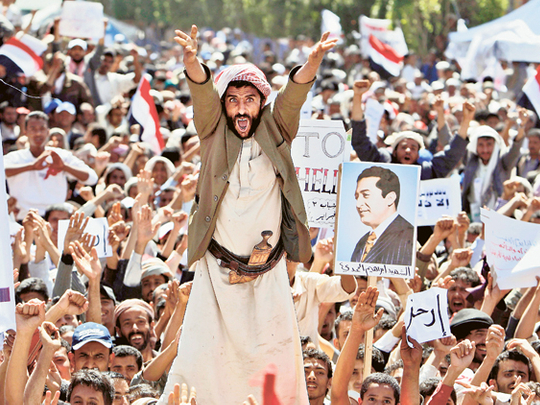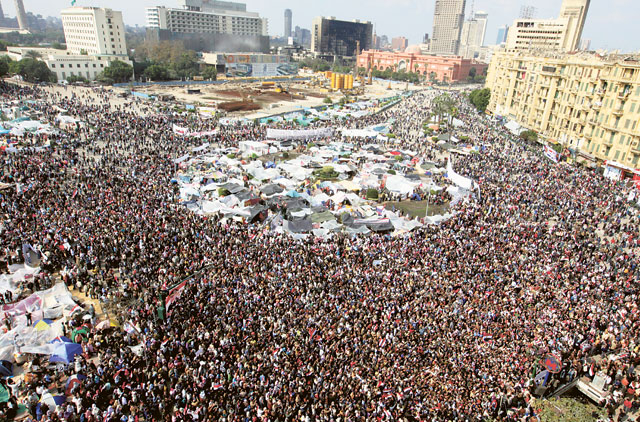
The Arab Spring that swept the region in 2011 took the world by surprise and a number of Arab regimes that had enjoyed absolute power for decades found themselves at the receiving end of deep-seated public anger and frustration.
The spark which set off the chain of events was the self-immolation of Tunisian Mohammad Bu Azizi whose desperate act embodied the frustration of Arab citizens across the region who decided enough was enough. No longer would they be afraid of autocratic and corrupt regimes and the decades of oppression culminated in an unrelenting rage that saw the departure of the Tunisian, Egyptian, and Yemeni leaders.
Perhaps the most extreme case was the demise of Libyan dictator Muammar Gaddafi who was killed by his own people following months of violence. However, many observers say that, despite the unprecedented nature of the Arab Spring, it was a revolution that was decades in the making.
In the first part of the 20th century Arab states fought and won their independence from European states: Syria, Lebanon, Tunisia, Algeria and Morocco from France; Libya from Italy; Jordan, Iraq and most of the Arabian Peninsula from Britain. Republics and monarchies emerged to fill the political vacuum. Some states were more successful than others in establishing civil society and institutions, but there was a marked failure to implement proper development in many a case.
Fatal flaw
Political observers pointed to this failure as they struggled to find an answer to the question: why did this happen? "Instead of investing in development, the states invested in their self-preservation — police states emerged. This failure of development plunged the Arabs into poverty," Abla Abou Elbah, a member of the Jordanian parliament explained.
Naziha Al Shaikh, a teacher from Tunisia, told Gulf News, that what happened in her country was an indication of how desperate the situation had become. "Every day we were hearing news of people risking their lives to emigrate to Italy or Malta. Social injustice, corruption and high employment were running rampant," she said.
Although the turn of events began in Tunisia, it soon spread like wildfire across the region. As the world rushed to explain the events — it led to much debate and confusion about what exactly the revolutions were aiming to achieve and at what expense. Each country faced its own unique triggers and circumstances but the unifying link seemed to be the fact that the people were no longer afraid and realised that, if they were ever to overthrow their dictators, they had to capitalise on the momentum. On January 18, a baker from the Egyptian coastal city of Esmailiya set himself ablaze outside parliament in central Cairo in protest against alleged official harassment. His suicide attempt instantly evoked comparisons between Egypt and Tunisia where autocrat Zine Al Abidine Bin Ali had been forced to flee to Saudi Arabia four days earlier.
The youth step up
"Egypt is not like Tunisia," several senior officials in Mubarak's National Democratic Party said. Young Egyptians saw things differently, however. People recalled the killing of Egyptian blogger Khalid Saeed, 28, in June 2010 at the hands of police brutality — images of Saeed's head bashed against the wall re-emerged on social networking sites. His sympathisers soon set up a Facebook page named after him. Titled ‘We all are Khalid Saeed', the page quickly generated a massive following and catalysed protests against Mubarak's rule.
Events unfolded rapidly in January, specifically following the call of a young woman, Egyptian activist Asmaa Mahfouz, who posted a video blog of herself on the internet with the exhortation: "If you think yourself a man, come with me on 25 January. Whoever says women shouldn't go to protests because they will get beaten let him have some honour and manhood and come with me on 25 January. Whoever says it is not worth it because there will only be a handful of people, I want to tell him, ‘You are the reason behind this, and you are a traitor, just like the president or any security cop who beats us in the streets."
On February 11, only two weeks after massive demonstrations in Tahrir Square, Hosni Mubarak stepped down after 33 years of rule. The image of the former leader behind bars at his own trial was further catalyst for Arabs elsewhere to rise up. "The Arab elite had entered a phase of historic cowardice — the youth who spearheaded the region's protests woke us up to know that democracy is possible," Mohammad Auajjar, a member of the Supreme Council for Audiovisual Communication in Morocco, said.
Indeed it was the youth who were at the forefront of protests. Young women stood alongside men, often leading protests and showing no fear. Surprisingly for the conservative society of Yemen, women made up nearly half of the protesters. One woman, Tawakul Karman, was singled out with unique recognition and awarded the Nobel Peace Prize for her activism against the regime of Ali Abdullah Saleh. Tawakul became the first Arab woman, the youngest person ever, to become a Nobel Peace Laureate and only the second Muslim woman ever to be recognised in that category.
Bushra Al Mugtari, another Yemeni young woman activist gave Gulf News an insight into the economic collapse and inequality that had made the people's lives unbearable. "Before January 2011, people were afraid of the regime's suppression. The political elite who were supposed to take the initiative and lead the masses, isolated themselves from the people. However, when the waves of change swept Tunisia and Egypt, we realised that we can also rise up and make change. The youth decided not to wait for the elites nor the elderly political parties to take action," she explained.
It was the youth again who took the lead when protests erupted in the Libyan city of Benghazi on February 16. Libya, under the rule of Muammar Gaddafi, had always been something of an enigma to other Arabs. The closed police society under the rule of its deranged leader rarely made any headlines in the outside world. Political foes were imprisoned or killed and the beginning of the uprising was largely inaccessible to the media due to strict government controls.
In the Libyan case, victory did not come quickly. As revolutionary fighters fought Gaddafi's forces, they began liberating the country slowly starting from the East until the capital was overrun in August. For the first time, the world saw pictures and video footage of the country and heard the voice of the Libyan people.
Similarly, Syrians under the thumb of Bashar Al Assad began their own revolution in March. Their struggle has proved to be the most complex of the Arab Spring as the regime still remains in power although opposition and army defections are steadily growing. Daily violence which has left over 5,000 Syrians dead has only been reported by social media forums. At the beginning of the Arab Spring, the Syrian president told the Wall Street Journal that his people would not revolt against him. "Syria is stable. Why? Because you have to be very closely linked to the beliefs of the people."
In March, Syrian boys who watched the revolutions in Cairo and Tunis on television, painted the walls with revolutionary slogans in Daraa. The 15 boys between the ages of 10 and 15 were arrested, beaten, burned and had their fingernails pulled out. When security forces opened fire on their families who had marched to the governor's house, the foundation for the uprising was laid.
At the turn of the year, Al Assad is faced with a vastly different reality — a country facing civil war, and widespread calls for an end to dictatorship by people who are no longer afraid.
— With inputs from Habib Toumi, Bahrain Bureau Chief; Saeed Al Batati, Yemen Correspondent, and Ramadan Al Sherbini in Egypt













